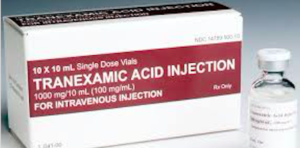The single greatest complication during and after facelift surgery is bleeding. Presurgical infiltration of a lidocaine and epinephrine solution is injected into the facelift incisions and planned undermined skin flaps. This helps to control the amount of bleeding encountered during surgery but its effects are time limited. When it wears off in the immediate postoperative period subsequent bleeding/hematoma can occur.

In the July 2020 issue of the Aesthetic Surgery Journal an article was published on this topic entitled ‘Prospective Study Assessing the Effect of Local Infiltration of Tranexamic Acid on Facelift Bleeding’. In this paper the authors used subcutaneous injections of TXA combined with lidocaine and epinephrine to assess its effects of rebound bleeding and postoperative drainage during facelift surgery. Over a nine (9) month period, thirty-nine (39) facelift patients were injected subcutaneously with 1 or 2 mg/mL TXA with 0.5% lidocaine/1:200,000 epinephrine.
Their results showed under seven (7) minutes for hemostats to be achieved. Drain outputs were under 15mls per day by postoperative day 1 and 15mls by postoperative day 2. Drains were removed thereafter. No hematoma or postoperative bleeding was encountered.
In thisclinical series TXA was used without untoward effects. This is a small number of patients to draw any definitive conclusions about its effectiveness for hematoma prevention. It would have been more helpful to infiltrate the two sides of the facelift differently, one side with TXA and the other without.
I would question whether epinephrine can be completely eliminated or should be. The mechanism of action of epinephrine and TXA is quite different. Epinephrine causes vasoconstriction to lower intraoperative bleeding while TXA is a clot stabilizer to prevent postoperative bleeding. They work synergestically to decrease both intra- and postoperative bleeding. Given their low cost there would be no reason to not include both in a subcutaneous infiltration solution in facelift surgery.
Dr. Barry Eppley
Indianapolis, Indiana


